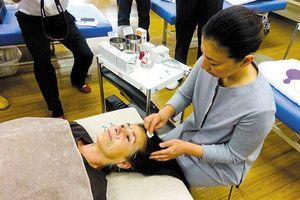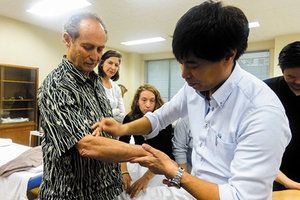TrA-2, my primary needle location, I needle 95% of the time and I think it works the best. You’ll know you have the right point location when you discover the muscle twitching when applying electric stimulation.
The Japan 6 Tour: Highlighting the Mystery of Japanese Acupuncture
In late October 2015, I had the opportunity to join the Japan 6 tour of acupuncture masters. This tour, the sixth to be offered, was organized by Stephen Brown, Jeffrey Dann, and Heather Suzuki and sponsored by the Acupuncture and Integrative Medicine College (AIMC) in Berkeley.
Japanese vs. TCM Acupuncture
Many American acupuncturists are not familiar with the difference between TCM and Japanese acupuncture. TCM acupuncture, as every American practitioner knows, prioritizes combinations of acupuncture points known for their energetic functions; eg, KI 7 to tonify kidney yang, SP 6 to tonify yin, etc. It is decidedly a zang-fu organized approach, and is the main system taught in both Chinese and American TCM colleges. TCM prioritizes disease or disorder (Epigastric Pain, Dysmenorrhea) and offers 3 to 5 point treatments for diseases as differentiated by zang-fu pathologies. TCM acupuncture was institutionalized as the acupuncture model in China after 1956, based on a teaching curriculum organized by the TCM herbalists. In doing so, alternative channel-oriented systems disappeared from the established curriculum.
Japanese acupuncture prioritizes channel imbalances rather than zang-fu pathologies. In Keiraku Chiryo, or Meridian Therapy, the 12 acupuncture channels are examined and corrected for imbalances of excess or deficiency. The idea is that if the body is in fundamental balance, it will go on to heal itself. Branch treatment is added to address the major complaint, and in modern practice, can include specific Japanese point applications or other systems such as ear acupuncture, symmetrical treatment, and even TCM point application.

Besides balancing meridians as its primary focus, Japanese style is unique for its manual techniques. Diagnosis includes sensitive palpation of the channels and pulse; therapy employs light and shallow needling, and is often combined with small, direct moxibustion, or moxa-needle. In addition, therapy is applied to the skin above channels using brushing and tapping techniques with metal teishin tools.
The Tour
Although studying and practicing Japanese acupuncture for many years, the Japan 6 tour was my first actual trip to Japan. The tour offered an in-depth exposure to palpation and manual techniques, particularly the uniquely Japanese approach to moxibustion and non-needle applications using various teishin tools. The course highlighted the importance of feeling the skin along the channels to evaluate excess, deficiency, stasis, dampness or dryness. Light brushing and light palpation were employed in diagnosis and scraping or tapping along the channels with teishin devices or warming moxa were used for therapy.

During the tour, we were trained by five masters, each giving a one-day presentation combining lecture and supervised training. The first two were in Tokyo, given at the Goto College of Medical Arts and Sciences. Our first teacher was Kouya Miyakawa, the president of the Japan Nei Jing Association and a protégé of Shudo Denmai. He started with a talk differentiating the Chinese approach from the Japanese approach and pointing out that Japanese acupuncture flows more from the Daoist perspective inspired by Lao Zi. Taking quotes from the Dao De Jing, this sensei (master teacher) emphasized promoting health and long life, improving skill based on single mindedness, and respecting suppleness, balance, and flow. He also pointed out that TCM is more inspired by the Huang Di Nei Jing (180 BCE), while Japanese acupuncture is based on the Nan Jing (180 CE). The principle inspiration for meridian balancing, for example, comes from the Nan Jing, Chapter 77, "When there is excess, reduce. Where there is deficiency, supplement."

Sensei Miyakawa emphasized the importance of observation and palpation of the channels, below the elbow and knee, and on the torso. Developing one's palpation skill on the level of the skin was the key to diagnostic success. The channel can be assessed by lightly stroking above the skin, a little deeper into the fascia, or deeper still into the muscle, looking for various blockages that constrain the flow of qi. This guided his treatment, which he executed with needle and moxa-needle. ("If hot, disperse. If cold, use moxa.") He said to try to return the patient's skin to that of a baby: soft, warm, moist and with luster. Following treatment, the patient's skin noticeably improved.
Our second teacher in Tokyo was Katsuhiro Yamada, a moxa master in practice for 46 years. His topic was Sawada-style Taikyoku (Taiji) Therapy. This is a whole body regulation using direct moxibustion and it has the effect of building immunity and promoting health and longevity. The three burners (jiao) are evaluated for warmth, heat, cold or dampness. The upper jiao regulates the zong qi, the middle jiao regulates the ying qi, and the lower jiao regulates the yuan/source qi. Balancing treatment is applied to channels along the arms and legs, as well as torso and back.

Master Yamada applies direct moxa using 5-7 extremely tiny pieces, the size of a sesame seed. Besides balancing channels and torso, there is a basic Sawada protocol to promote health and immune function. Here, direct moxa is applied to Ren 12, Ren 6 (or 4), SJ 4 (left), LI 11, St 36 and Ki3 or 6. On the back, the protocol uses Du 12, Bl 17, Bl 18, Bl 20, Bl 23, Bl 52 (or GB 25), and Bl 32. After his talk and demonstrations, we were divided into groups to practice his moxa technique, lighting small cones on a thin petroleum jelly base - on paper towels! The cone was meant to discolor the paper, but not actually create a burn.
Shikoku Medical College
Taking a bullet train, we then went to Utazu on the distant island of Shikoku, to continue studies at the Shikoku Medical College. Our first teacher was Yoko Oasa, a director of the school and a specialist in facial acupuncture. Her treatment is not only for facial rejuvenation and beauty, but to promote stress relief. Sensei Oasa exuded gentleness, relaxing the body by stroking meridians and applying teishin, needles, and needle moxa. Her facial needles, as all her needles, were Japanese gauge 00 (.12mm) and she applied 20 needles to the face, plus distal points including ST 40, ST 36 and DU 12 on all patients. The overall effect to the patient was one of total relaxation. "A healthy face reflects a healthy body."

Our second teacher in Shikoku was Funamizu Takahiro, a master of teishin non-needle technique. Dr. Takahiro is one of the principle organizers of next year's World Federation of Acupuncture conference to be held in Tokyo and a disciple of Akizo Okada. His mastery of teishin was very impressive, indicated by his speed and touch. Teishin involves using metal or other hard materials as tools to brush, tap, or flick at channels and locations of blockages. To me, it seemed the application of pediatric shoneishin tools and techniques to adults, regulating the channels along and beneath the skin.
Sensei Takahiro concentrated his talk on the treatment of psychological problems, including depression and anxiety. His treatments sought to balance the sympathetic and parasympathetic nervous systems and he was engaged in research showing the efficacy of teishin devices versus needle. Psychological problems primarily involve imbalances of the kidney and heart, as well as the liver and spleen, with the Bladder and Du channels acting as important regulators. He used the afternoon to demonstrate various techniques, while supervising and training the students in the group.
Our third teacher in Shikoku was Hideyoshi Higushi, who came down from the north of Japan. Sensei Higushi is a revered and experienced clinician with 46 years in practice. His preferred treatment is using warming moxa. His device is a hollow bamboo tube with a cotton cloth rubber-banded to the bottom. Inside is a layer of salt over which a large chunk of moxa is burned. The tube is gently massaged over the area needing warmth, especially on the torso or back. Sensei Higushi demonstrated this on a woman's abdomen and on a child with asthma. He would slowly move the device over the abdomen, for the women, and along the back and upper torso of the child. Sensei Higushi reiterated his belief for all treatments – do often, do lightly.
In gynecology, the teacher shared his clinical experience regarding infertility, amenorrhea, heavy menses and PMS. For infertility, he observed that treating anxiety was as important as regulating the period. His clinical research indicated that acupuncture done weekly for six months prior to IVF, greatly increased success. Following pregnancy, acupuncture weekly in the first trimester or 16 weeks was important for preventing miscarriage.
The Experience
These two-week trainings are offered once a year. What I saw and what I learned were the incredible hand techniques using teishin, light and superficial needling and moxa, both direct and indirect. This is acupuncture as an art, demanding skill and finesse by the practitioner. I recommend anyone interested in training with advanced masters in Japan contact the organizers, JeffreyDann@gmail.com or Heather Suzuki at mayalikesmonkeys@me.com. For a very cool demonstration of Japanese manual skills, look at the promo film for the upcoming 2016 WFAS conference to be held in Tokyo at www.drjakefratkin.com/WFAS.



